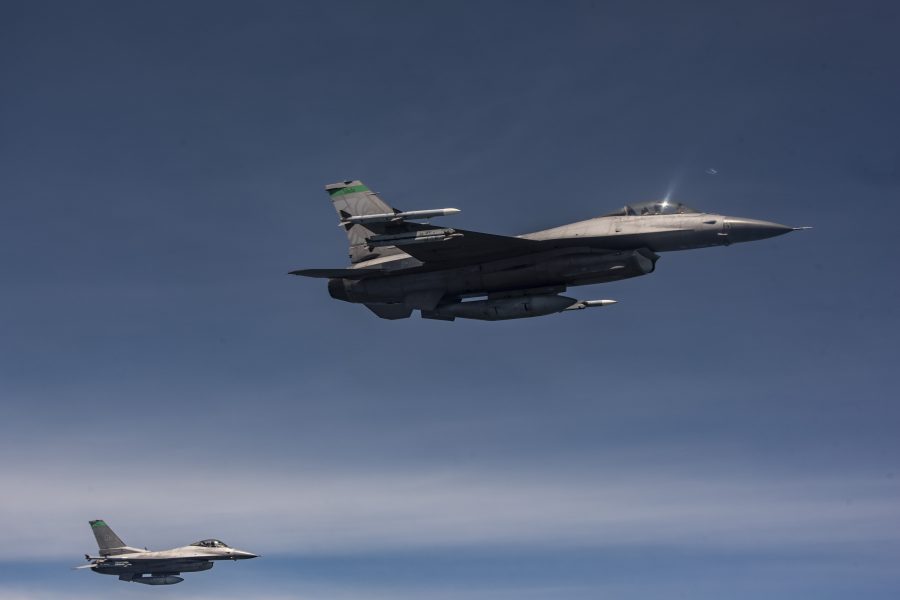House lawmakers approved three amendments aimed at curtailing Air Force plans to retire aging fighter jets as both the Senate and House began marking up their respective drafts of the 2024 defense authorization bill.
The three amendments tacked onto the House Armed Services Committee’s version of the bill include:
- Protecting F-16s. Rep. Carlos A. Giménez (R-Fla.), won support for a measure that would block the Air Force from retiring any F-16 Fighting Falcons until at least 180 days after it submits a report to Congress on “any plans” to divest F-16 aircraft over the next five years. That period covers the length of the Air Force’s future years defense program (FYDP), in which the Air Force plans to retire 125 of the “oldest and least capable F-16s,” according to Pentagon budget documents.
- Protecting the size of the overall fighter fleet. Rep. Don Bacon (R-Neb.), a retired Air Force brigadier general, won approval for an amendment requiring a report to Congress by Jan. 19, 2024, on how the Air Force plans to meet its fighter capacity requirements.
- Protecting the Air National Guard. Bacon also authored an amendment establishing a floor for the size of the Air National Guard’s fighter fleet. Less prescriptive than an earlier bill backed by Bacon, this measure would prohibit the Air Force from terminating the flying mission of any Guard fighter squadron until at least 180 days after USAF submits a “notional plan” on how it will recapitalize every Guard fighter squadron.
The reports required by these provisions would force the Air Force to explain how its divestments will impact fighter capacity and how it will mitigate those effects as aircraft are retired.
The Air Force has about 900 F-16s in its inventory today, so the Air Force’s plan to retire 125 of the jets is a reduction of nearly 14 percent.
In approving Bacon’s measures, the House Armed Services Committee appears to challenge the Air Force’s argument that it can manage the loss of existing aircraft with appropriate risk.
“The committee believes that further reductions will significantly increase operational demands on a diminishing inventory of fighter aircraft and personnel and create conditions for an impending readiness crisis,” the amendment states. “The committee acknowledges the Department of the Air Force’s stated intent to modernize the fighter fleet but concludes that its current procurement plan is insufficient and will fail to deliver the fighter capacity and capability required by the National Defense Strategy.”
To overcome that risk, the measure requires a detailed report to Congress no later than Jan. 19, 2024, detailing USAF fighter capacity requirements and how those will be met, including:
- The number of fighter squadrons needed to meet peacetime and wartime needs
- The modernization and recapitalization plan to meet those squadron requirements
- The authorities and resources needed to increase fighter production and forestall the need to deactivate squadrons
- The extent to which Collaborative Combat Aircraft (CCA) can be counted on to mitigate manned fighter requirements
- Mitigation measures planned should the CCA program be delayed or canceled.
Concerns about CCAs come in response to Air Force officials suggesting they could help achieve “affordable mass” because they will be less costly than manned fighters. The Air Force wants to invest $5.8 billion in CCA development over the next five years, with Secretary Frank Kendall having posited a notional fleet of 1,000 CCA drones.
Bacon’s National Guard measure seeks options for replacing retiring aircraft “at a rate that ensures recapitalization of such squadrons with relevant and more capable replacement fighter aircraft.” The Air Force has promised it can protect units, or even flying units, but not necessarily fighter squadrons, but Bacon is focused on ensuring continuity of National Guard fighter operations.
“The most experienced pilots and maintainers in the Air Force are in our Air National Guard,” Bacon said during the hearing. “When we cut these squadrons, you will not regain this capability. … We cannot let our Air National Guard be cut to a size that we cannot grow back easily over the next decade or two decades.”
The Air Force is seeking support to retire 57 F-15C/D fighters that have been flown hard and are surpassing their useful operational life, and 42 A-10 attack aircraft it says fall short of requirements for survivability in future high-end fights . Many of those older aircraft are in the Air National Guard.
